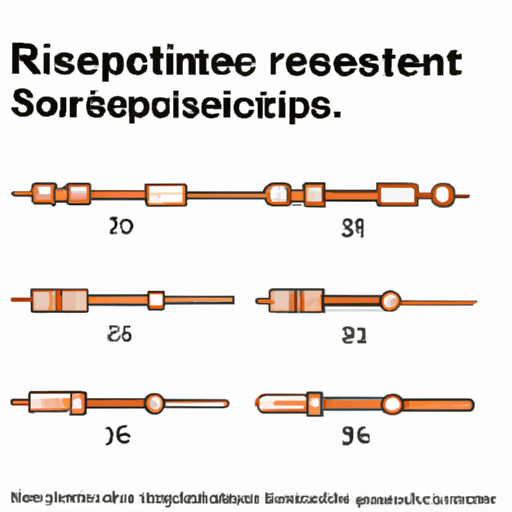What are the product standards for resistor resistance?
What are the Product Standards for Resistor Resistance?
I. Introduction
Resistors are fundamental components in electronic circuits, serving the critical function of controlling current flow. By providing resistance, they help to manage voltage levels, protect sensitive components, and ensure the proper functioning of electronic devices. Given their ubiquitous presence in everything from consumer electronics to complex industrial systems, the reliability and performance of resistors are paramount. This is where product standards come into play. These standards ensure that resistors meet specific criteria for quality, safety, and performance, thereby fostering trust among manufacturers, designers, and consumers alike. This blog post will explore the product standards for resistor resistance, detailing their significance, key parameters, compliance processes, and future trends.
II. Understanding Resistor Resistance
A. Basic Principles of Resistance
At the heart of resistor functionality lies the concept of resistance, which is defined by Ohm's Law: \( V = I \times R \), where \( V \) is voltage, \( I \) is current, and \( R \) is resistance. Resistors can be categorized into fixed and variable types. Fixed resistors have a constant resistance value, while variable resistors, such as potentiometers, allow for adjustable resistance.
B. Factors Affecting Resistance
Several factors influence the resistance of a resistor:
1. **Material Properties**: The type of material used in a resistor significantly affects its resistance. Common materials include carbon, metal film, and wire-wound elements, each offering different resistance characteristics.
2. **Temperature Coefficients**: The resistance of materials can change with temperature. The temperature coefficient of resistance (TCR) quantifies this change, indicating how much the resistance will vary with temperature fluctuations.
3. **Physical Dimensions**: The size and shape of a resistor also play a role in its resistance. Longer and thicker resistors typically have lower resistance, while shorter and thinner ones have higher resistance.
III. Key Product Standards for Resistors
A. International Electrotechnical Commission (IEC) Standards
The IEC is a leading organization in developing international standards for electrical and electronic devices. The IEC 60115 series outlines specifications for fixed resistors, including performance, testing methods, and reliability. Additionally, IEC 60063 provides a standard for preferred numbers, which helps in selecting resistor values.
B. American National Standards Institute (ANSI) Standards
In the United States, ANSI plays a crucial role in establishing standards for various components, including resistors. ANSI/IEEE standards provide guidelines for resistor performance, while ANSI C63 focuses on electromagnetic compatibility, ensuring that resistors do not interfere with other electronic components.
C. Joint Electron Device Engineering Council (JEDEC) Standards
JEDEC is instrumental in setting standards for semiconductor and passive components, including resistors. Their standards help ensure compatibility and reliability across various applications, particularly in the semiconductor industry.
D. Other Relevant Standards
1. **ISO (International Organization for Standardization)**: ISO standards cover a wide range of quality management and safety practices, which can also apply to resistor manufacturing.
2. **RoHS (Restriction of Hazardous Substances)**: This directive restricts the use of specific hazardous materials in electronic components, including resistors, promoting environmental sustainability.
IV. Key Parameters Specified in Resistor Standards
A. Resistance Value Tolerance
Tolerance refers to the allowable deviation from the specified resistance value. It is crucial for ensuring that resistors perform as expected in a circuit. Common tolerance levels include 1%, 5%, and 10%, with tighter tolerances being essential for precision applications.
B. Temperature Coefficient of Resistance (TCR)
The TCR indicates how much a resistor's resistance changes with temperature. A low TCR is desirable for applications requiring stable performance across varying temperatures. Typical TCR values range from ±5 ppm/°C for precision resistors to ±100 ppm/°C for general-purpose resistors.
C. Power Rating
The power rating of a resistor defines the maximum power it can dissipate without failure. It is calculated using the formula \( P = I^2 \times R \) or \( P = \frac{V^2}{R} \). Understanding power ratings is vital for circuit design, as exceeding this rating can lead to overheating and failure.
D. Voltage Rating
The voltage rating specifies the maximum voltage a resistor can handle before breaking down. This parameter is critical in preventing resistor failure, which can lead to circuit malfunctions or damage to other components.
E. Reliability and Lifetime Testing
Reliability testing methods, such as life testing and humidity testing, assess how resistors perform under various conditions over time. These tests are essential for ensuring that resistors can withstand the rigors of their intended applications, particularly in critical sectors like aerospace and medical devices.
V. Compliance and Certification
A. Importance of Compliance with Standards
Compliance with established standards is crucial for ensuring the safety and reliability of resistors. It helps manufacturers avoid costly recalls and enhances consumer trust in their products.
B. Certification Processes for Resistors
Third-party testing laboratories play a vital role in the certification process. They evaluate resistors against relevant standards and provide certification marks, such as UL (Underwriters Laboratories) and CE (Conformité Européenne), indicating compliance with safety and performance criteria.
C. Consequences of Non-Compliance
Failure to comply with standards can result in severe consequences, including product recalls, legal liabilities, and damage to a company's reputation. Manufacturers must prioritize compliance to mitigate these risks.
VI. Industry Applications and Implications of Standards
A. Consumer Electronics
In consumer electronics, resistors are used in various applications, from audio equipment to smartphones. Adhering to standards ensures that these devices function reliably and safely.
B. Automotive Industry
The automotive industry relies heavily on resistors for various functions, including sensor applications and power management. Compliance with standards is critical for ensuring vehicle safety and performance.
C. Medical Devices
In medical devices, precision and reliability are paramount. Resistors must meet stringent standards to ensure patient safety and device efficacy.
D. Aerospace and Defense
In aerospace and defense applications, resistors must withstand extreme conditions. Compliance with rigorous standards is essential for ensuring the reliability of critical systems.
E. Implications of Standards on Product Design and Safety
Adhering to product standards influences the design process, encouraging manufacturers to prioritize safety, reliability, and performance in their products.
VII. Future Trends in Resistor Standards
A. Advances in Materials and Technology
As technology evolves, new materials and manufacturing techniques are emerging, leading to the development of resistors with improved performance characteristics.
B. Impact of the Internet of Things (IoT) on Resistor Standards
The rise of IoT devices necessitates the development of new standards to address the unique challenges posed by interconnected systems, including power management and electromagnetic compatibility.
C. Sustainability and Environmental Considerations in Resistor Manufacturing
With increasing awareness of environmental issues, manufacturers are focusing on sustainable practices, including the use of eco-friendly materials and processes that comply with RoHS and other environmental standards.
VIII. Conclusion
In conclusion, product standards for resistors play a vital role in ensuring the quality, reliability, and safety of electronic components. By adhering to established standards, manufacturers can enhance consumer trust and ensure that their products perform as intended. As technology continues to advance, it is essential for manufacturers and designers to prioritize compliance with these standards, fostering innovation while maintaining safety and reliability in electronic devices.
IX. References
1. IEC 60115 Series - International Electrotechnical Commission
2. ANSI/IEEE Standards - American National Standards Institute
3. JEDEC Standards - Joint Electron Device Engineering Council
4. ISO Standards - International Organization for Standardization
5. RoHS Directive - European Union
This blog post provides a comprehensive overview of the product standards for resistor resistance, highlighting their significance and implications across various industries. By understanding these standards, stakeholders can make informed decisions that enhance the performance and reliability of electronic components.






